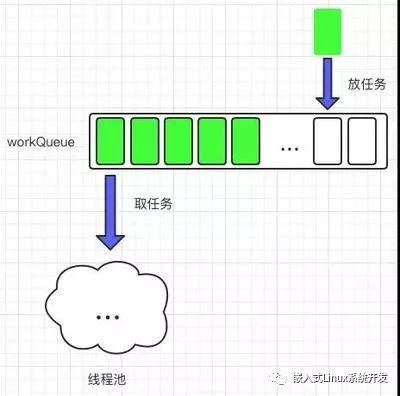处理多线程的方式可以采用线程池,可以将“生产者”线程提出任务列表添加到“任务列表”,然后一些线程自动完成“任务队列”的任务。

多线程编程,创建一个线程,指定去完成某一个任务,等待线程的退出。虽然能够满足编程需求,但是当我们需要创建大量的线程的时候,在创建过程以及销毁线程的过程中可能会消耗大量的CPU.增加很大开销。如:文件夹的copy、WEB服务器的响应。
线程池就是用来解决类似于这样的一个问题的,可以降低频繁地创建和销毁线程所带来地开销。
线程池技术思路:一般采用预创建线程技术,也就是提前把需要用线程先创建一定数目。这些线程提前创建好了之后,“任务队列”里面假设没有任务,那么就让这些线程休眠,一旦有任务,就唤醒线程去执行任务,任务执行完了,也不需要去销毁线程,直到当你想退出或者是关机时,这个时候,那么你调用销毁线程池地函数去销毁线程。
线程完成任务之后不会销毁,而是自动地执行下一个任务。而且,当任务有很多,你可以有函数接口去增加线程数量,当任务较少时,你可以有函数接口去销毁部分线程。
如果,创建和销毁线程的时间对比执行任务的时间可以忽略不计,那么我们在这种情况下面也就没有必要用线程池。
“任务队列”是一个共享资源“互斥访问”

线程池本质上也是一个数据结构,需要一个结构体去描述它:
struct pthread_pool //线程池的实现
{
//一般会有如下成员
//互斥锁,用来保护这个“任务队列”
pthread_mutex_t lock; //互斥锁
//线程条件变量 表示“任务队列”是否有任务
pthread_cond_t cond; //条件变量
bool shutdown; //表示是否退出程序 bool:类型 false / true
//任务队列(链表),指向第一个需要指向的任务
//所有的线程都从任务链表中获取任务 "共享资源"
struct task * task_list;
//线程池中有多个线程,每一个线程都有tid, 需要一个数组去保存tid
pthread_t * tids; //malloc()
//线程池中正在服役的线程数,当前线程个数
unsigned int active_threads;
//线程池任务队列最大的任务数量
unsigned int max_waiting_tasks;
//线程池任务队列上当前有多少个任务
unsigned int cur_waiting_tasks;
//......
};
//任务队列(链表)上面的任务结点,只要能够描述好一个任务就可以了,
//线程会不断地任务队列取任务
struct task //任务结点
{
// 1. 任务结点表示的任务,“函数指针”指向任务要执行的函数(cp_file)
void*(* do_task)(void * arg);
//2. 指针,指向任务指向函数的参数(文件描述符)
void * arg;
//3. 任务结点类型的指针,指向下一个任务
struct task * next;
};
线程池框架代码如下,功能自填:
操作线程池所需要的函数接口:pthread_pool.c 、pthread_pool.h
把“线程池”想象成一个外包公司,你需要去完成的就是操作线程池所提供的函数接口。
pthread_pool.c
#include "pthread_pool.h"
/*
init_pool: 线程池初始化函数,初始化指定的线程池中有thread_num个初始线程
@pool:指针,指向您要初始化的那个线程池
@threa_num: 您要初始化的线程池中开始的线程数量
返回值:
成功 0
失败 -1
*/
int init_pool(pthread_pool * pool , unsigned int threa_num)
{
//初始化线程池的结构体
//初始化线程互斥锁
pthread_mutex_init(&pool->lock, NULL);
//初始化线程条件变量
pthread_cond_init(&pool->cond, NULL);
pool->shutdown = false ;// 不退出
pool->task_list = (struct task*)malloc(sizeof(struct task));
pool->tids = (pthread_t *)malloc(sizeof(pthread_t) * MAX_ACTIVE_THREADS);
if(pool->task_list == NULL || pool->tids == NULL)
{
perror("malloc memery error");
return -1;
}
pool->task_list->next = NULL;
//线程池中一开始初始化多少个线程来服役
pool->active_threads = threa_num;
//表示线程池中最多有多少个任务
pool->max_waiting_tasks = MAX_WAITING_TASKS;
//线程池中任务队列当前的任务数量
pool->cur_waiting_tasks = 0;
//创建thread_num个线程,并且让线程去执行任务调配函数,
//记录所有线程的tid
int i = 0;
for(i = 0; i tids)[i], NULL, routine, (void*)pool);
if(ret != 0)
{
perror("create thread error");
return -1;
}
printf("[%lu]:[%s] ===> tids[%d]:[%lu]",pthread_self(),
__FUNCTION__, i , pool->tids[i]);
}
return 0;
}
/*
routine: 任务调配函数。
所有线程开始都执行此函数,此函数会不断的从线程池的任务队列
中取下任务结点,去执行。
任务结点中包含“函数指针” h "函数参数"
*/
void * routine(void * arg)
{
//arg表示你的线程池的指针
while()
{
//获取线程互斥锁,lock
//当线程池没有结束的时候,不断地从线程池的任务队列取下结点
//去执行。
//释放线程互斥锁,unlock
//释放任务结点
}
}
/*
destroy_pool: 销毁线程池,销毁前要保证所有的任务已经完成
*/
int destroy_pool(pthread_pool * pool)
{
//释放所有空间 等待任务执行完毕(join)。
//唤醒所有线程
//利用join函数回收每一个线程资源。
}
/*
add_task:给任务队列增加任务, 把do_task指向的任务(函数指针)和
arg指向的参数保存到一个任务结点,添加到pool任务队列中。
@pool : 您要添加任务的线程池
@do_task : 您需要添加的任务(cp_file)
@arg: 您要执行的任务的参数(文件描述符)
*/
int add_task(pthread_pool *pool,void*(* do_task)(void * arg), void*arg)
{
//把第二个参数和第三个参数封装成struct task
//再把它添加到 pool->task 任务队列中去
//注意任务队列是一个共享资源
//假如任务后要唤醒等待的线程。
}
//如果任务多的时候,往线程池中添加线程 pthread_create
int add_threads(pthread_pool * pool, unsigned int num);
{
//新创建num个线程,让每一个线程去执行线程调配函数
//将每一个新创建的线程tid,添加到pool-> tids
}
//如果任务少的时候,减少线程池中线程的数量 pthread_cancel join
int remove_threads(pthread_pool * pool, unsigned int num)
{
//用pthread_cancel取消num个线程
//利用pthread_join函数去回收资源。
}
pthread_pool.h
#ifndef __PTHREAD_POOL_H__
#define __PTHREAD_POOL_H__
//表示线程池中最多有多少个线程
#define MAX_ACTIVE_THREADS 20
//表示线程池中最多有多少个任务
#define MAX_WAITING_TASKS 1024
//任务队列(链表)上面的任务结点,只要能够描述好一个任务就可以了,
//线程会不断地任务队列取任务
struct task //任务结点
{
// 1. 任务结点表示的任务,“函数指针”指向任务要执行的函数(cp_file)
void*(* do_task)(void * arg);
//2. 指针,指向任务指向函数的参数(文件描述符)
void * arg;
//3. 任务结点类型的指针,指向下一个任务
struct task * next;
};
struct pthread_pool //线程池的实现
{
//一般会有如下成员
//互斥锁,用来保护这个“任务队列”
pthread_mutex_t lock; //互斥锁
//线程条件变量 表示“任务队列”是否有任务
pthread_cond_t cond; //条件变量
bool shutdown; //表示是否退出程序 bool:类型 false / true
//任务队列(链表),指向第一个需要指向的任务
//所有的线程都从任务链表中获取任务 "共享资源"
struct task * task_list;
//线程池中有多个线程,每一个线程都有tid, 需要一个数组去保存tid
pthread_t * tids; //malloc()
//线程池中正在服役的线程数,当前线程个数
unsigned int active_threads;
//线程池任务队列最大的任务数量
unsigned int max_waiting_tasks;
//线程池任务队列上当前有多少个任务
unsigned int cur_waiting_tasks;
//......
};
/*
init_pool: 线程池初始化函数,初始化指定的线程池中有thread_num
个初始线程
@pool:指针,指向您要初始化的那个线程池
@threa_num: 您要初始化的线程池中开始的线程数量
返回值:
成功 0
失败 -1
*/
int init_pool(pthread_pool * pool , unsigned int threa_num);
/*
routine: 任务调配函数。
所有线程开始都执行此函数,此函数会不断的从线程池的任务队列
中取下任务结点,去执行。
任务结点中包含“函数指针” h "函数参数"
*/
void * routine(void * arg);
/*
destroy_pool: 销毁线程池,销毁前要保证所有的任务已经完成
*/
int destroy_pool(pthread_pool * pool);
/*
add_task:给任务队列增加任务, 把do_task指向的任务(函数指针)和
arg指向的参数保存到一个任务结点,添加到pool任务队列中。
@pool : 您要添加任务的线程池
@do_task : 您需要添加的任务(cp_file)
@arg: 您要执行的任务的参数(文件描述符)
*/
int add_task(pthread_pool *pool,void*(* do_task)(void * arg), void*arg);
//如果任务多的时候,往线程池中添加线程 pthread_create
int add_threads(pthread_pool * pool, unsigned int num);
//如果任务少的时候,减少线程池中线程的数量 pthread_cancel join
int remove_threads(pthread_pool * pool, unsigned int num);
#endif
以上就是关于Linux C下线程池的使用的分享教程,有不足之处大家多多指正。
为各位朋友分享的相关内容。想要了解更多Linux相关知识记得关注公众号“良许Linux”,或扫描下方二维码进行关注,更多



 微信扫一扫打赏
微信扫一扫打赏
 支付宝扫一扫打赏
支付宝扫一扫打赏

.png)
